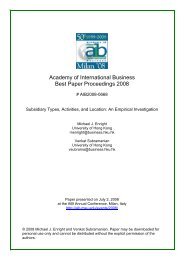AIB 2012 Conference Proceedings - Academy of International ...
AIB 2012 Conference Proceedings - Academy of International ...
AIB 2012 Conference Proceedings - Academy of International ...
You also want an ePaper? Increase the reach of your titles
YUMPU automatically turns print PDFs into web optimized ePapers that Google loves.
TUESDAY<br />
emerging markets or developed economies. We illustrate the framework using case study examples <strong>of</strong> different<br />
emerging multinationals. The paper concludes with fruitful avenues for future research. (For more information,<br />
please contact: Margarete Kalinowski, ESADE Business School, Spain: margarete.kalinowski@esade.edu)<br />
Turning Lead into Gold: The Case <strong>of</strong> Chinese and Indian Multinationals' <strong>International</strong>ization<br />
Filip De Beule, KU Leuven<br />
This paper analyzes the internationalization pattern <strong>of</strong> Chinese and Indian multinationals by looking into the<br />
location determinants <strong>of</strong> their greenfield subsidiaries. On the basis <strong>of</strong> a conditional logit gravity model, it<br />
analyzes whether these determinants vary by the type <strong>of</strong> activity –such as extraction, manufacturing, sales <strong>of</strong><br />
products or services, and R&D- being internationalized. Given that these Emerging Market Firms (EMFs) have<br />
developed competitive advantages that fit their home country environment, the analysis shows that they<br />
predominantly go to similarly economic environments but not to similarly institutional environments. In fact, a<br />
greater positive institutional distance attracts more investments, while a greater economic distance deters<br />
investment. This result is robust for all types <strong>of</strong> investment, except extraction. This latter type <strong>of</strong> subsidiary is<br />
predominantly drawn to resource intensive countries. R&D subsidiaries are also shown to significantly locate in<br />
countries with similar market and better institutional environments, indicating that both Chinese and Indian<br />
firms largely carry out knowledge exploiting greenfield investments abroad. (For more information, please<br />
contact: Filip De Beule, KU Leuven, Belgium: filip.debeule@lessius.eu)<br />
Resources and Multinational Expansion <strong>of</strong> ASEAN Firms<br />
Nuruzzaman Arsyad, <strong>International</strong> University <strong>of</strong> Jakarta<br />
Peter Hwang, <strong>International</strong> University <strong>of</strong> Jakarta<br />
This study investigates the type <strong>of</strong> resources that firms draw upon to expand internationally in the ASEAN<br />
context. This paper seeks to understand the impact <strong>of</strong> technological, networking, and accumulated knowledge<br />
resources on ASEAN firms' multinationality, moderated by labor intensity, the type <strong>of</strong> ownership and the stage<br />
<strong>of</strong> economic development. We found that technology resource is positively associated with multinationality.<br />
Moreover, the high labor intensity firms will benefit more from the impact <strong>of</strong> technology resource on<br />
multinationality than low labor intensive firms. For manager industry experience, we found an inverted U-shape<br />
relationship and for manager education we found a positive relationship with multinationality. Lastly, while<br />
networking is important across firms in ASEAN, over-networking applies to foreign firms but not local firms. As<br />
such, over-networking appears to be situation specific rather than a generalized concept. (For more information,<br />
please contact: Nuruzzaman Arsyad, <strong>International</strong> University <strong>of</strong> Jakarta, Indonesia: nuruzzaman@ssb.ac.id)<br />
Session: 3.4.4 - Competitive<br />
Track: 4 - Strategy, Alliances, and Competitiveness<br />
Governance and Innovation in <strong>International</strong> Alliances<br />
Presented On: July 3, <strong>2012</strong> - 14:30-15:45<br />
Chair: Jean-Francois Hennart, Tilburg University; Queens University; Singapore Management University<br />
Non-Complementary Governance Mechanisms in <strong>International</strong> Technology Alliances and Innovation Capabilities<br />
Yong Kyu Lew, University <strong>of</strong> Hull<br />
This paper investigates governance mechanisms in international technology alliances (ITAs), firm-level<br />
innovation capabilities, and performance outcomes in the mobile computing market. This high-tech market is<br />
characterized by numerous cross-border strategic technology collaborations between s<strong>of</strong>tware and hardware<br />
<strong>AIB</strong> <strong>2012</strong> <strong>Conference</strong> <strong>Proceedings</strong><br />
Page 247

















